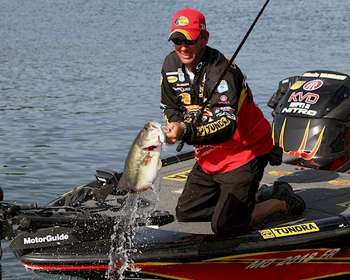
There's no doubt that five-time Toyota Tundra Bassmaster Angler of the Year Kevin VanDam knows his crankbaits. Over the course of his career, the Michigan pro has raked in hundreds of thousands of dollars casting and cranking on lakes across the United States.
When it comes to selecting the right crankbait color for the job, VanDam says that there's a rhyme and reason for every color in his boat. "Crankbait colors are really important," says VanDam. "With shad being the primary forage in the majority of lakes across the country, you have to have shad patterns to fit all the different water clarities."
For starters, VanDam always approaches a new body of water with two primary colors of Strike King crankbaits tied on — Sexy Shad and Chartreuse Sexy Shad. "Those are, without a doubt, the two main colors that I use the most when I'm cranking," he allows.
When water clarity hovers around the 2-foot mark, which occurs in many lakes across the country, he says that the Sexy Shad color gives off a natural glow. If he is faced with 18 inches to 2 feet of visibility, Chartreuse Sexy Shad gets the nod. "The Chartreuse Sexy Shad has a little more flash to it," he explains. "With limited visibility, it's a great alternative to the original Sexy Shad." In stained water, VanDam chooses bold colors to give the bass a more visible target.
"If the water is a little dirtier, that's when I like to start introducing the brighter colors like the Chartreuse Shad, or a crankbait with a lime green back, chartreuse sides and an orange belly, like a Chartreuse Crawfish. The brighter colors really increase the visibility of the bait," he says. While many weekend anglers may shy away from throwing crankbaits in stained water, VanDam points out that bass don't necessarily have to see the bait in order to strike.
"They're going to hear the rattles and feel the water that the bait is moving," he explains. "I think the color just helps the fish eat the bait better if it's visible for them once they get close." As the water clarity increases, VanDam opts for more natural shades of baitfish, gravitating toward natural and translucent colors. When fishing the clear waters in his home state of Michigan, Clear Sexy Shad and Ghost Minnow are two of his favorite options.
Light penetration is another factor that plays into crankbait color selection. On sunny days, translucent colors get the nod because they will look much more like a natural baitfish in the water. On cloudy days, VanDam says that it's hard to beat the Sexy Shad color because it creates a distinct silhouette. Regardless of his color selection, VanDam says it's important to try to match the color of the most prevalent baitfish in the lake.
"There are times, especially with smallmouth, when you can use a chartreuse or solid color crankbait and have success. But day in and day out, the more natural your bait looks and the closer it matches the real baitfish, the better off you'll be."
(Provided by Z3 Media)




